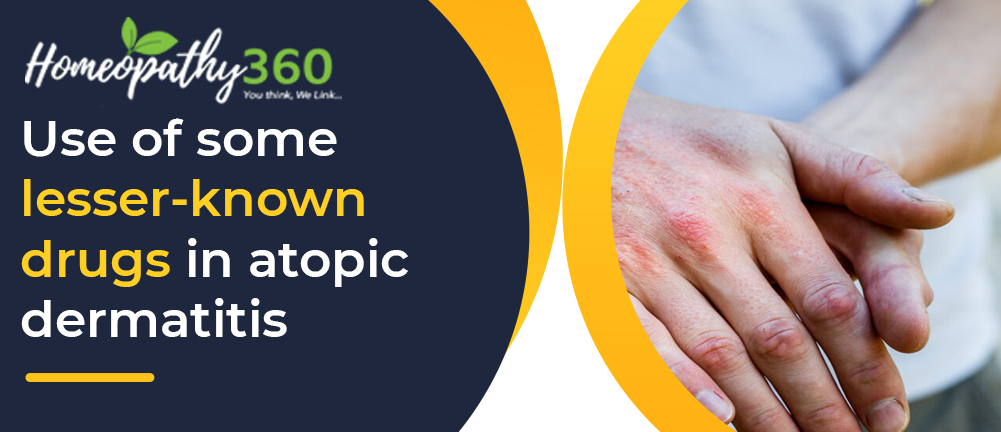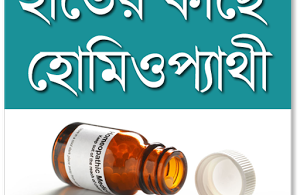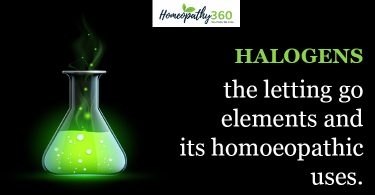
ABSTRACT
Atopic Dermatitis is a chronic skin disorder which is the cause of concern for the patients, from the cosmetic view point as well as cost factor, for its treatment. Homoeopathy is popular for successful treatment of skin disorders including atopic dermatitis. Besides the polychrest medicines, some rare lesser known drugs have been used by the homoeopathic professionals and found effective in the management of such skin disorder. The indications of a few of such medicines are stated in this article.
KEYWORDS:-Atopic dermatitis, Homoeopathy, Lesser known drugs.
ABBREVIATIONS: atopic dermatitis (AD), immunoglobulin (Ig)
INTRODUCTION
Atopic dermatitis (AD) or atopic eczema is an itchy, inflammatory non- contagious skin condition with a predilection for the skin flexure. It is characterised by poorly defined erythema with oedema, vesicles , and weeping in acute stage and thickening in the chronic stage.(1)Atopic dermatitis is the cutaneous expression of the atopic state, characterised by a family history of asthma, hay fever, or dermatitis in up to 70% of patients.(2)The clinical presentation varies widely at different ages and places . Pruritus is a prominent characteristics of AD which usually precedes the rash(“itch that rashes“) and it may be severe, especially at night. It is followed by inflammatory red to brownish grey coloured patches with small, raised bumps which may leak fluid and form crusts when scratched. Although the patches can occur anywhere, they most often occur on the flexural surfaces of the joints (“flexural eczema”), such as sides of elbows, knees, and ankles.Clinically, AD has been divided in to three stages -infantile, childhood, and adulthood phases based on some characteristic clinical features.(3) The aetiology of AD is only partially known. There is a clear genetic predisposition .When both the parents are affected by AD, over 80% of their children manifest the disease .When one of the parents is affected, the prevalence drops to slightly over 50%. Patients with AD may display a variety of immunoregulatory abnormalities including increased IgE synthesis; increased specific IgE to foods, aero-allergens, bacteria and bacterial products.(2) The aetiology behind AD is thought to be epidermal barrier destruction by immune system dysregulation caused due to gene- environmental interaction.(3) The diagnosis of AD is mostly based on clinical features.(1) The clinical criteria for the diagnosis of atopic dermatitis are: pruritus and scratching; course marked by exacerbation and remissions; lesions typical of eczematous dermatitis; personal or family history of atopy(asthma, allergic rhinitis, food allergies or eczema), and clinical course lasting longer than 6 weeks.(2)
The prevalence of AD is estimated to be 15-20% in children and 1-3% in adults, and the incidence has increased by 2-3 fold during past decades in industrialised countries.(4)studies suggest that atopic dermatitis imposes a high economic burden.(1)
Homoeopathic system of treatment has a good reputation for successful treatment of chronic skin disorders including AD. Apart from the constitutional medicines, well known rare drugs documented in homoeopathic materia medica also play an important role in the treatment of AD. In this article, some lesser known drugs which are frequently used by the physicians for the treatment of atopic dermatitis are discussed.
1. Juglans cineria
Common name-Butternut (5,6,7)
Family-Juglandaceae (6,7)
Signs and symptoms (5,6,8)
- Eczema especially on the lower extremities, sacrum, hands and wrists, frequently recurring with intolerable itching and soreness.
- Itching and pricking pain on being over heated.
- Pustules on thighs, hips and nates with itching and burning pain.
- Erythema and erysipelatous redness.
- Itching on head, neck and shoulders with burning pain and redness; must scratch the scalp constantly.
- Concomitant: Skin affection associated with liver complaints.
Potency: Mother tincture to third potency. (5)
2. Juglans regia
Common name-Walnut (5,6,7)
Family-Juglandaceae (6,7)
Signs and symptoms (5,6,7)
- Itching eruptions over the whole body; behind the ears of children
- Eruptions on flexor surface of right forearm near elbow with burning pain and red spots.
- Pustules red, itching with burning pain; cracked skin discharging a greenish fluid stiffening the linen.
- Itching in axilla with burning pain; skin sore and cracked, then red and scaly,< after perspiration.
- Scalp red and itches violently, <at night.
Potency: Mother tincture and lower potencies. (5)
3.Piper methysticum
Common name-Kava kava, Macropier methysticum (6,7)
Family– Piperaceae (6,7)
Signs and symptoms (5,6,7)
- Dryness of skin especially where it is thick as on hands and feet, with scales and cracks.
- Scaly eruptions; fall of scales leave white spots which often ulcerate.
Potency: Mother tincture and lower potencies. (5)
4.Aethiops mercurialis
Common name-Black sulphide of mercury (6,7)
Signs and symptoms (5,6,7)
- Eczematous eruptions and discharges.
- Favus like eruptions.
- Painful, irritating, scaby eruptions on face.
- Eruptions after fright.
- Discharges are offensive.
Potency: Lower trituration especially the second decimal. (5)
5.Skookum chuck
Common name-Mineral springs, Skookum limechen chuck(strong medicine water), Medical lake (6,7)
Signs and symptoms (6,7)
- An antipsoric remedy having strong affinity for the skin and mucus membranes.
- It is a very good medicine for chronic eczema.
- Eczema of feet with fissured skin and acrid secretions.
- Dryness of skin especially on scalp; falling of hair.
- Note-Besides internal administration of Skookum Chuck, the Skook soap and ointment have also been used.
Potency: Third trituration. (5)
6.Oleander
Common name-Rose laurel (5,6,7)
Family-Apocynaceae (6,7)
Signs and symptoms (5,6,7,8)
- Violent itching eruptions of various parts of the body; bleeding, oozing; absence of perspiration.
- Itching eruptions especially on scalp, which are sensitive. Itching compels the patient to scratch.
- Vesicular eruptions around head in children; scaly eruptions on posterior part of head behind ears, with itching as from lice.
- Very sensitive skin, slightest friction causes soreness and chapping.
- Skin very sensitive with redness and excoriation even when gently scratched.
- Skin symptoms,<undressing, friction of clothes, night.
Potency: Third to thirtieth potency. (5)
7. X-ray
Common name:X-ray (7)
Signs and symptoms ( 7)
- Dry, itching eczema.
- Chronic, papular, vesicular, itching eruptions.
- Palms rough and scaly.
- Skin discoloured, pale, sclerous, cold; or dry, wrinkled.
- Hyperkeratosis of the skin.
- Erythema around roots of nails; nails thickened.
- Painful cracks.
- Skin symptoms, <in bed, evening and night, open air.
Potency: Twelfth potency and higher.(5)
8.Lappa arctium
Common name-Burdock(5,6,7),
Family-Compositae(6,7)
Signs and symptoms (5,6,7,8)
- Moist, foul eczema of infants.
- Sticky eruptions on head and face.
- Eczema on scalp with moist offensive, greyish white crusts; eruptions spread to face with itching and tearing pain.
- Skin symptoms associated with cold sweat from axillae.
Potency: Mother tincture to third potency. (5)
9.Xerophyllum
Common name-Tamalpais, basket grass flower (5,7)
Family-Melanthiaceae (7)
Signs and symptoms (5,7)
- Skin rough and cracked, feels like leather.
- Erythema with vesication and intense itching, stinging and burning pain.
- Dermatitis, especially around the knees.
- Blisters like little lumps.
- Itching, <application of cold water, evening
>application of hot water, morning.
Potency: Sixth potency or higher. (5)
10. Viola tricolor
Common name-Pansy(5,6,7)
Family– Violaceae(6,7)
Signs and symptoms (5,6,7,8)
- The principal use of this medicine is for eczema of childhood with intolerable itching.
- Eczematous eruptions, particularly over face (except eyelids), head and behind the ears with intolerable itching and burning pain.
- Itching and burning pain, <at night.
- Thick hard scabs with cracks here and there, from which a tenacious yellow pus exudes.
- Skin symptoms, < winter.
Potency: Lower potencies. (5)
11.Arundo mauritanica
Common name-Reed, Italian grass (7)
Family-Gramineae (7)
Signs and symptoms (5,7)
- Eczema with itching and crawling sensation especially on chest and upper extremities.
- Eczema especially behind the ears.
- Fissures in fingers and heels.
Potency: Third to sixth potency. (5)
12.Manganum aceticum
Common name– Manganese acetate ( 6,7)
Signs and symptoms (6,7)
- Chronic eczema with amenorrhoea, < during menses or menopause.
- Red elevated spots with voluptuous itching, > by scratching.
- Burning pain all over skin, in evening and when rising from bed.
- Skin rough, cracked with bluish discolouration.
- Deep cracks in bends of elbows and knees.
- Skin eruptions, <cold wet weather.
Potency: Third to thirtieth potency. (5)
13.Rhus veneta
Common name-Poison elder (5,6,7)
Family– Anacardiaceae (6,7)
Signs and symptoms (5,6,7)
- Eczematous eruptions with excessive itching.
- Vesicles, erysipelas; skin dark red.
- Itching, >relieved by hot water.
- Vesicular eruptions on forearm, wrist and back of hand between the fingers.
- Itching and desquamation of skin of hands.
Potency: Sixth to thirtieth potency. (5)
14.Galphimia glauca
Common name-Galphimia glauca (7)
Family-Malpighiaceae (7)
Signs and symptoms (7)
- Very good remedy for allergic eczema.
- Vesicular, papular eruptions.
- Pruritus with sensitive skin.
- Eczema with history of hay fever and asthma.
Potency: Mother tincture and all potencies. (7)
15.Scrophularia nodosa
Common name-Knotted figwort (7)
Family-Scrophulariaceae (7)
Signs and symptoms (7)
- Eczema of the ears especially behind the right ear.
- Affected skin surface burns when rubbed.
- Prickling, itching, <back of hands, inside wrists and between fingers.
- Eczema around the navel.
Potency: Mothertincture and first potency. (5)
WAY AHEAD…
- Lesser -known drugs effective in the management of atopic dermatitis should be thoroughly proved /reproved;
- Efforts to be made to bring the Indian drugs useful in the management of atopic dermatitis to the domain of Homoeopathy after potentization, to facilitate their use by the homoeopathic profession, after proper proving, as per Hahnemannian guidelines;
- Clinical verification of all these lesser- known drugs needs to be undertaken, following proper protocol;
- After thorough proving and clinical verification of these lesser-known drugs, their utility in treating atopic dermatitis should be clinically tested by the clinician and documented for use by the entire homoeopathic fraternity, which will ultimately benefit the patients.
REFERENCES
1. Williams HC. Clinical practice. Atopic dermatitis. The New England Journal of Med. 2005; 352(22):2314-24.
2. Fauci AS, Braunwald E, Kasper DL, Hauser SL, Longo DL, Jameson JL, editors. Harrison’s Principles of Internal Medicine. Vol.1. 15th ed. USA: McGraw Hill;2001.
3. Parveen S. Homoeopathic treatment in a case of co-morbid atopic dermatitis and depressive disorder. Indian J Res Homoeopathy.2016;10(1):75-82.
4. Odhiambo JA, Williams HC, Clayton TO, Robertson CF, Asher MI. Global variations in prevalence of eczema symptoms in children from ISAAC phase Three. J Allergy Clin Immunol. 2009;124(6):1251-1258.
5. Boericke W. New Manual of Homoeopathic Materia Medica with Repertory. 3rd ed. New Delhi: B Jain Publishers(P) Ltd.;2007.
6. Clarke JH. A Dictionary of Practical Materia Medica. Vol.1-3. New Delhi: B Jain Publishers(P)Ltd.;2005.
7. Murphy R. Lotus Materia Media,1400 Homoeopathic and Herbal Remedies.3rd ed. New Delhi: B Jain Publishers(P)Ltd.;2006.
8. Farrington EA. Comparative Materia Medica.18th ed. New Delhi: B Jain Publishers(P)Ltd.;2017.
About Author:
Chaturbhuja Nayak
Formerly: Director General, Central Council for Research in Homoeopathy, Govt. of India, New Delhi; President of Homoeopathy University, Jaipur ,Rajasthan & Principal-cum-Superintendent of Dr. A.C. Homoeopathic Medical College & Hospital, Bhubaneswar, Odisha, India.
Anupama Giri
MD(Hom.),3rd Year,Department of Materia Medica, Dr. A. C. Homoeopathic Medical College & Hospital, Bhubaneswar, Odisha, India.





